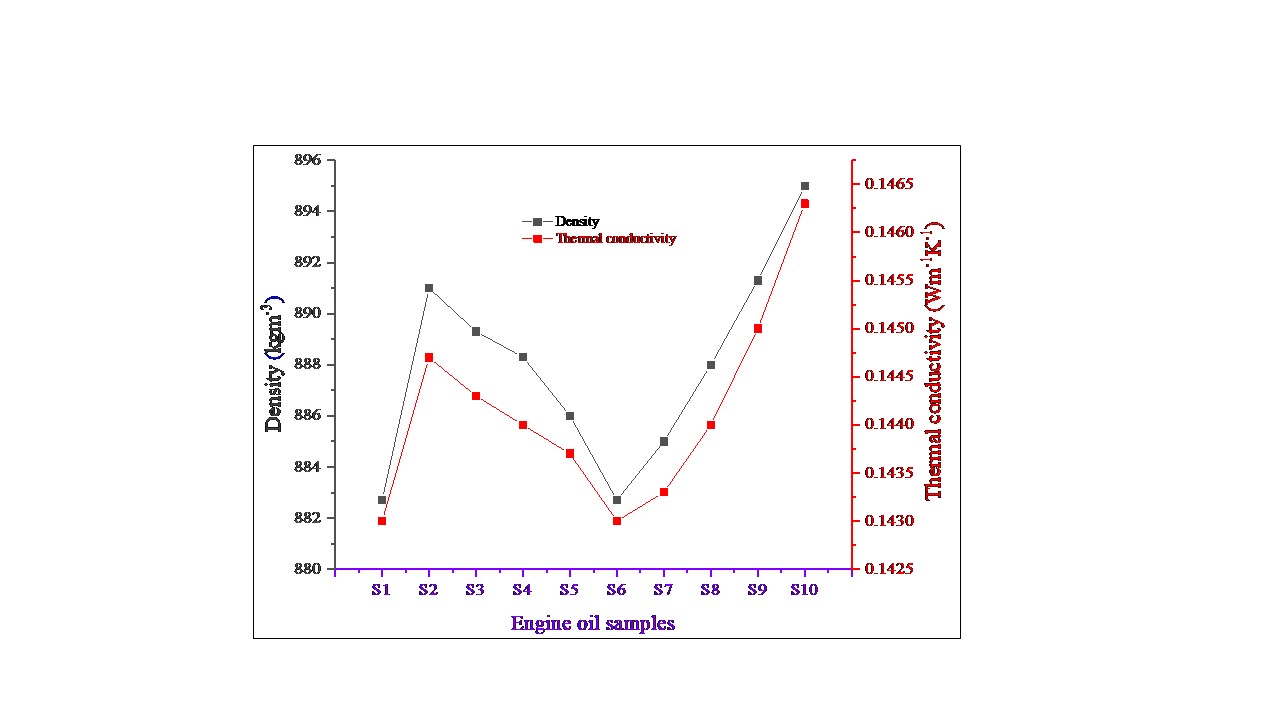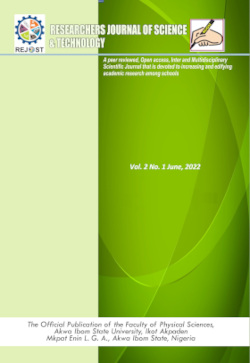A Comparative and Analytical Study of the Energy Economy and Environmental Impacts of Engine Oils in Nigeria: An Examination of Thermophysical Properties
Keywords:
Engine Oils, Thermophysical Properties, Energy Efficiency, Environmental Impact, NigeriaAbstract
This study investigates the energy economy and environmental impacts of commonly-used engine oils in Nigeria by analyzing their thermophysical properties. Limited public literature on these oils has left several energy and environmental issues inadequately addressed by governmental regulators. Ten popular engine oils were selected: Master Super (SAE 40), Abro (SAE 20W-50), Sea Horse (SAE 20W-50), Oando Oleum Super (SAE 40), Climax Auto Lube (SAE 40), Conoil Golden Super (SAE 40), Total Classic (SAE 40), Tonimas ENEZ Heavy Duty (SAE 40), Mobil Super (20W-50 XUP), and Ammasco Vital 2000 SL (SAE 20W-50), coded as S1 through S10, respectively. Thermophysical testing revealed that dynamic viscosity decreased across all samples as temperatures rose from 40°C to 100°C, with S10 showing the highest viscosities (427 cP and 106 cP) and S1 the lowest (255 cP and 66 cP). The oils also showed variations in density (882.7–895.0 kg/m³), thermal conductivity (0.1430–0.1463 W/mK), specific heat capacity (1832–1921 J/kgK), and thermal diffusivity (8.433–8.923 × 10⁻⁹ m²/s), indicating discernible property relationships. Flash points ranged from 230°C to 262°C. Samples S2, S3, S4, S8, S9, and S10 demonstrated high wear protection under stressful conditions but tended to degrade more rapidly at elevated temperatures. In contrast, S1, S5, S6, and S7 exhibited balanced properties, optimizing engine performance, reducing fuel and energy consumption, and potentially minimizing toxic emissions. The findings underscore the need for further regulatory focus on engine oil standards to support energy efficiency and environmental protection.
References
Akpabio G. T., George N. J. and Udofia K. M. (2010). Determination of Thermal and Physical Properties of Sediments in the Niger Delta Using Wire-line log data. Physics Scholars Research, Library, 1 (4), 48-55.
Akpabio G. T., George N. J., Akpan A. E. and Obot I. B. (2010). Thermal Response of some select Wood samples for a Passively Cooled Building Design, Archives of Applied Science Research, 2 (2), 267 - 276.
Abdullah L., Anwer T. K. (2023). Determination the Viscosity of different types of Engine Oil in Kurdistan. https://doi.org/10.131-40/RG.2.2.29960.49926
Adebogun, A., Hudson, R., Matthews, A., Withers, P. J. (2020). Industrial Gear Oils: Influence of Bulk Oil Temperature and Contact Pressure on Tribological Performance and Subsurface Changes, Tribology Letters, 68: 48.
Afonso I. S., Nobrega G., Lima R., Gomes J. R., Ribeiro, J. E. (2023). Conventional and Recent Advances of Vegetable Oils as Metalworking Fluids (MWFs): A Review. Lubricants, 11(4): 160.
ASTM D92 (2018). Standard Test Method for Flash and Fire Points by Cleveland Open Cup Tester, ASTM International, West Conshohocken, PA.
ASTM D5334 (2022). Standard Test Method for Determination of Thermal Conductivity of Soil and Rock by Thermal Needle Probe Procedure, ASTM International, West Conshohocken, PA.
Awad A.M., Sukkar khalid A., Jaed D. M. (2022). The Effect of Various Parameters on the Thermophysical and Rheological Properties of SiO2 Nano-Lubricating Oil in Petroleum Refineries. Journal of Petroleum Research and Studies, 12: 68 - 91.
Desai N., Nagaraj A. M., Sabnis N. (2021). Analysis of thermo-physical properties of SAE20W40 engine oil by the addition of SiO2 nanoparticles, Materialstoday: Proceedings, 47(16): 5646 – 5651. https://-doi.org/10.1016/j.matpr.2021.03.688
Dittes N. J. (2016). Condition Monitoring of Water Contamination in Lubricating Grease for Tribological Contacts. Luleå University of Technology, Luleå, Sweden.
Du C., Sheng C., Liang X., Rao X., Guo Z. (2023). Effects of Temperature on the Tribological Properties of Cylinder-Liner Piston Ring Lubricated with Different Oils, Lubricants, 11(3): 115.
Engineering ToolBox (2023). Engine Oil - Density and Specific Heat vs. Temperatures. https://www.engineering-toolbox.com/engine-oil-density-specific-heat-vs-temperature-d¬_2227.html.
Etuk S. E., Akpan N. I., George, N. J., Samuel D. E. and Nathaniel. E. U. (2016). Comparative Study of Thermal Conductivity Values of Different Percentage Compositions of Ground Arachis hypogea (Groundnut) Husk and Vignaunguiculata (Beans) Husk Compressed Fiberboards. Journal of Thermal Science and Engineering Applications, USA, Vol. 8 / 024501-1.
George N. J., Obianwu V. I., Akpan A. E., Obot, I. B. (2010a). Lubricating and cooling capacities of different SAE 20W – 50 engine oil samples using specific heat capacity and cooling rate, Archives of Physics Research, 2010, 1(2):103 – 111
George, N. J., Akpabio, G.T. and Udofia K. M. (2010b). The Implication of Oil Spillage on the Thermal Properties of Soil Samples in the Niger Delta, Southern Nigeria. Scholars Research Library, 4 (4), 64-72.
Hasan-Zadeh, A., Poshtiban, M. (2021). Car Engine Oil: Investigation of Function and Related Challenges, and Provision of Environmental Solutions, Asian Journal of Applied Sciences, 9(1); 35 – 44
Iboh, U.A., Ebong, S.T., Robert, U.W., Sandy, C.F., Efiang, J.A. (2023). Determination of the Density and Viscosity of Engine Oil with Grade 20w-50 in Nigeria. International of Journal of Natural and Practical Sciences, 5(1): 1 – 11
Kanu, M. O., Gabriel, W., Nasiru, Z. M. (2018). The specific heat capacities and rate of cooling of some grades of engine oil samples, FUW Trends in Science & Technology Journal, 3(2B): 736 – 739
Kodali, D.R. (2014). Development, properties and applications of high-performance biolubricants, Chapter 17, Advances in Biorefineries Biomass and Waste Supply Chain Exploitation, 556 - 595.
Kadirgama, G., Lee, M.A.M.A., Ramasamy, D., Kadirgama, K., Samykano, M., Yusaf, T. (2024). Thermal Properties of Engine Oils through the Integration of Graphene Nanoparticles: A Greener Approach for Sustainable Mechanical Systems, E3S Web of Conferences, 488: 02011. https://doi.-org/10.1051/e3sconf/202448802011
Kartika, A., Kurniawan, A., Krensa, A. (2023). Analysis of the Temperature Effect on the Liquids Viscosity, Journal Penelitian dan Pembelajaran Fisika Indonesia, 5(1): 25 - 30.
Klowak, M., Gracyalny, G. (2014). Engine oil recirculation system for extended maintenance interval: 14/453048
Lan, P., Iaccino, L.L., Bao, X., Polycarpou, A.A. (2020). The effect of lubricant additives on the tribological performance of oil and gas drilling applications up to 200 °C, Tribology International, 141: 105896
Liu, W., Qiao, X., Liu, S. Chen, P. (2022). A Review of Nanomaterials with Different Dimensions as Lubricant Additives, Nanomaterials (Basel), 12(21): 3780.
Mansur, H., Ibrahim, K.A., Halidu, A.A. (2022). Measurements of pour points, flash points, water contents and viscosity of some selected automobile oils used as lubricants in Nigeria, Science World Journal, 17 (1): 168 – 170
Marques, M. A. C., Guimarey, M. J. G., Domínguez-Arca, V., Amigo, A., Fernández, J. (2021). Heat capacity, density, surface tension, and contact angle for polyalphaolefins and ester lubricants, Thermochimica Acta, 703: 178994. https://-doi.org/10.1016/j.tca.2021.178994
Musa, B., Muhammad, B.A., Shehu, P. (2023). Impacts and Management of Vehicular used Lubricating Oil: A Threat to Environmental Sustainability in Kaduna Metropolis, Nigeria. Conference: 62nd Annual National Conference of The Association of Nigerian Geographers, Hosted by Department of Geography At: University of Nigeria, Nsukka
Nagy, L., Knaup, J., Zsoldos, I. (2019). Investigation of Used Engine Oil Lubricating Performance through Oil Analysis and Friction and Wear Measurements, Acta Technica Jaurinensis, 12(3): 237 – 251
Nwite, J.N., Alu, M.O. (2015). Effect of different levels of spent engine oil on soil properties, grain yield of maize and its heavy metal uptake in Abakaliki, Southeastern Nigeria, Journal of Soil Science and Environmental Management, 5(4): 44 - 51. https://doi.org-/10.5897/JSSEM12.070
Obi, A.I., Aisimi A.M., Dauda, M., Nwogu, C. (2013). Studies of Some Engine Oils Manufactured In Nigeria, Journal of Metallurgy and Materials Engineering, 8: 52 – 60.
Omar, S., Salehi, F. M., Farooq, U., Morina, A., Neville, A. (2021). Chemical and physical assessment of engine oils degradation and additive depletion by soot, Tribolog International, 160: 107054.
Owunna, I.B., Ikpe, A.E. (2023). A Technical Report on the Effects of Lubricating Fluids (Lubricants) on Service Performance of Machine Parts, International Summit Scientific Research Congress, 15 - 17, Gaziantep, Türkiye
Pabsetti, P., Murty, R.S.V.N., Bhoje, J., Mathew, S., Harivenkatesh, K., Rahul, F.M. (2023). Performance of hydraulic oils and its additives in fluid power system: A review, IOP Conference Series: Earth and Environmental Science, 1161: 012009.
Pichler, J., Eder, R.M., Besser, C., Pisarova, L., Dörr, N., Marchetti-Deschmann, M., Frauscher, M. (2023). A comprehensive review of sustainable approaches for synthetic lubricant components, Green Chemistry Letters and Reviews, 16(1): 2185547
Puckace, J.S., Redmon, J J., Fitzgerald, H, Ismail, O.K. (2015). Method of determining optimal change interval for a functional fluid, Pub. No.: US 2013/0046433 A1
Rațiu, S., Alexa, V., Josan, A., Cioată, V.G., Kiss, I. (2020). Study of temperature dependent viscosity of different types of engine used oils, Journal of Physics: Conference Series, 1426: 012001. https://-doi.org/10.1088/17426596/1426/1/012001
Rawashdeh, M.O., Fayyad, S.M., Awwad, A.S. (2020). Testing Engine Oil Specifications and Properties and its Effects on the Engines Maintenance and Performance, WSEAS Transactions on Fluid Mechanics, 15: 140 – 148. https://doi.org/10.37394-/232013.2020.15.14
Sejkorová, M., Hurtová, I., Jilek, P., Novák, M., Voltr, O. (2021). Study of the Effect of Physicochemical Degradation and Conta-mination of Motor Oils on Their Lubricity, Coatings, 11: 60.
Shahnazar, S., Bagheri, S., Hamid, S.B.A. (2016). Enhancing lubricant properties by nanoparticle Additives, International Journal of Hydrogen Energy, 41:3153 - 3170.
Shehu, P., Musa, B.A., Zakka, S.D., Tanimu, A., Akanbi-Lawal, N.G., Yakubu, A.T. (2023). Effect of Mishandling and Vending of Used Engine Oil on the Environment, Health and Urban Planning in Kaduna Metropolis: A Call to Action for a Paradigm Shift. 1(1): 9-25. https://doi.org/10.55-121/upc.v1i1.100
Soodoo, N., Bouzidi, L., Narine, S.S. (2023). Fundamental Structure - Function Relationships in Vegetable Oil-Based Lubricants: A Critical Review, Lubricants, 11(7):284.
Tang, L., Zhang, Y., Li, C. Zhou, Z., Nie, X., Chen, Y., Cao, H., Liu, B., Zhang, N., Said, Z., Debnath, S., Jamil, M., Ali, H.M., Sharma, S. (2022). Biological Stability of Water- Based Cutting Fluids: Progress and Application, Chinese Journal of Mechanical Engineering, 35(3): 1–24. https://doi.org/10.1186/s10033-021-00667-z
Wu, X., Li, C., Zhou, Z., Nie, X., Chen, Y., Zhang, Y., Cao, H., Liu, B., Zhang, N., Said, Z., Debnath, S., Jamil, M., Ali, H.M., Sharma, S. (2021). Circulating purification of cutting fluid: an overview, The International Journal of Advanced Manufacturing Technology, 117(9-10): 2565 - 2600.

Downloads
Published
How to Cite
Issue
Section
License
Copyright (c) 2024 Researchers Journal of Science and Technology

This work is licensed under a Creative Commons Attribution-NonCommercial-NoDerivatives 4.0 International License.




